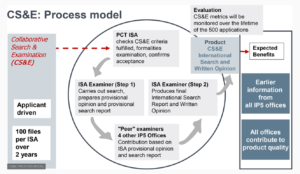
Readers will recall my article about Super Patents. If you want to try to get a Super Patent, you have to file a PCT application in one of the participating Receiving Offices and you have to select one of the participating International Searching Authorities (ISAs) and you have to file a form requesting acceptance into the Collaborative Search & Examination (CS&A) pilot program. And you have to get incredibly lucky to get one of the very small number of slots open for applicants in this pilot program.
Which raises the very interesting question — if you do all of these things, how do you find out if you got accepted into the pilot program? How do you find out whether your PCT application will receive an International Search Report and Written Opinion that resulted from the collaborative effort of five International Searching Authorities?
Just now I was delighted to learn that one of our firm’s clients got one of the small number of coveted slots in CS&E. But how did we learn this good news? How, as a general matter, does one learn that one has been accepted into this pilot program? Maybe you already knew the answer, but I did not. I was astonished at the answer.
The answer, at least if the ISA that you selected is ISA/KR (the Korean Intellectual Property Office), is that you find out that you have been accepted into CS&E only by accident. For this client’s application, we went into ePCT and we expanded the “DATA” section for the application. Within the DATA section we scrolled down to the “INTERNATIONAL SEARCH” section. And this is what we saw:

Yes it turns out that when ISA/KR decides to accept a particular application into CS&E, ISA/KR does nothing to communicate this news directly to the applicant. The only place where ISA/KR communicates this news is by logging in at ePCT and setting a flag in ePCT. You can see the flag in the screen shot above. The chief purpose of this flag is to give access to this application to the “peer” ISAs (in this case ISA/CN, ISA/EP, ISA/JP and ISA/US). The flag also signals to the peer ISAs that they will presently see the initial search and examination work product from ISA/KR in ePCT, and that they will presently be expected to carry out their “peer” work in the CS&E program for this application and to enter it into ePCT for review by ISA/KR.
Of course as we know some PCT applicants are not trendy, modern and up-to-date. Some PCT applicants do not use ePCT to manage their pending PCT applications. Such a PCT applicant would not be able to check this DATA field to learn whether its application had or had not been accepted into CS&E.
Even those PCT applicants that do use ePCT to manage their pending PCT applications might not be aware that this super-important tidbit of information may be found in this “DATA” place where you normally do not have any reason to go looking.
Of course now that you have read this blog article, you will know to go check in ePCT for each of your pending PCT applications in which you had requested acceptance into CS&E to see whether it has indeed been accepted into the program. And if you had not previously been making use of ePCT to manage your pending PCT applications, this would be as good a reason as any for you to start doing so.
Did you, prompted by this blog article, go and look in ePCT and learn for the first time that one of your PCT applications has been accepted into CS&E? If so, please post a comment below!
